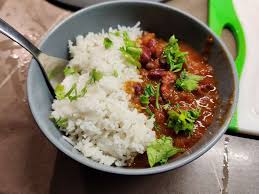Savor the Savory Delight: Kidney Bean Curry Recipe for a Flavorful Feast

Introduction:
Kidney bean curry recipe , also known as Rajma, is a delectable vegetarian dish that hails from the vibrant culinary landscape of India. Bursting with aromatic spices, creamy gravy, and tender kidney beans, this hearty curry is a favorite among both vegetarians and meat-eaters alike. In this article, we’ll embark on a culinary journey to explore the origins, nutritional benefits, and step-by-step instructions to prepare an irresistible kidney bean curry that will tantalize your taste buds and leave you craving for more.
A Brief History of Rajma:
The origins of kidney bean curry can be traced back to the northern region of India, particularly the states of Punjab and Kashmir, where it is a staple dish in many households. The name “Rajma” is derived from the Hindi word for kidney beans, and the dish has been a part of Indian cuisine for centuries. Traditionally, Rajma was cooked over a slow flame in earthen pots, allowing the flavors to meld together and create a rich, aromatic gravy. Over time, the dish has evolved, with various regional variations and adaptations, but its popularity has remained steadfast, both in India and across the globe.
Nutritional Benefits of Kidney Beans:
Kidney beans, the star ingredient of this curry, are not only delicious but also packed with essential nutrients and health benefits. Here are some reasons why kidney beans are a must-add to your diet:
High in Protein:
Kidney beans are an excellent source of plant-based protein, making them an ideal choice for vegetarians and vegans looking to meet their protein requirements.
Rich in Fiber:
With a high fiber content, kidney beans aid in digestion, promote satiety, and regulate blood sugar levels, making them beneficial for weight management and overall gut health.
Loaded with Vitamins and Minerals:
Kidney beans are rich in vitamins and minerals, including folate, iron, potassium, and magnesium, which support various bodily functions, including heart health, immune function, and bone strength.
Low in Fat:
Kidney beans are naturally low in fat and cholesterol, making them a heart-healthy addition to any diet.
Key Ingredients for Kidney Bean Curry:
To prepare a lip-smacking kidney bean curry, you’ll need the following ingredients:
2 cups dried kidney beans, soaked overnight and drained (or 4 cups canned kidney beans, rinsed and drained)
2 tablespoons vegetable oil or ghee
1 large onion, finely chopped
3 tomatoes, pureed
3 cloves garlic, minced
1-inch piece of ginger, grated
2 green chilies, slit lengthwise (adjust according to spice preference)
1 teaspoon cumin seeds
1 teaspoon coriander powder
1 teaspoon cumin powder
1 teaspoon turmeric powder
1 teaspoon red chili powder (adjust according to spice preference)
1 teaspoon garam masala
Salt to taste
Fresh cilantro leaves for garnish
Step-by-Step Instructions to Prepare Kidney Bean Curry:
Heat oil or ghee in a large pot or pressure cooker over medium heat. Add cumin seeds and let them splutter.
Add chopped onions and sauté until they turn golden brown.
Add minced garlic, grated ginger, and slit green chilies. Cook for a few minutes until the raw smell disappears.
Add the tomato puree to the pot and cook until the oil separates from the masala and the tomatoes are fully cooked.
Add coriander powder, cumin powder, turmeric powder, red chili powder, and salt. Mix well to combine.
Add the soaked and drained kidney beans to the pot and mix until they are well coated with the masala.
Pour in enough water to cover the kidney beans (about 4 cups) and bring the mixture to a boil.
If using a pressure cooker, close the lid and cook on medium heat for about 15-20 minutes, or until the kidney beans are tender. If using a regular pot, cover with a lid and simmer on low heat for about 45-50 minutes, or until the kidney beans are soft and cooked through.
Once the kidney beans are cooked, add garam masala and stir to incorporate.
Garnish with fresh cilantro leaves and serve hot with steamed rice or naan bread.
Variations and Tips:
For added creaminess, you can mash some of the kidney beans with the back of a spoon or a potato masher before adding the garam masala.
To enhance the flavor of the curry, you can add a tablespoon of dried fenugreek leaves (kasuri methi) along with the garam masala.
If you prefer a richer gravy, you can add a splash of heavy cream or coconut milk towards the end of cooking.
For a healthier version, you can substitute oil or ghee with olive oil or coconut oil, and adjust the amount of spices according to your taste preferences.
Kidney bean curry tastes even better the next day as the flavors intensify, so feel free to make a large batch and enjoy it as leftovers.
Conclusion:
Kidney bean curry, with its rich flavors, hearty texture, and nutritional benefits, is a quintessential dish in Indian cuisine that never fails to impress. Whether enjoyed as a comforting weeknight meal or served at festive gatherings, this versatile curry is sure to delight your taste buds and nourish your body. With our easy-to-follow recipe and helpful tips, you can now recreate the magic of authentic kidney bean curry in your own kitchen. So, roll up your sleeves, gather your ingredients, and get ready to savor the savory delight of this timeless Indian classic.









